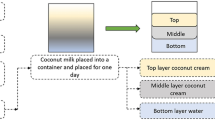Abstract
Polyphenols were extracted from the rape of Israeli olive oil using hexane, acetone and ethanol in a simple sequential procedure yielding three fractions (A,B,C). Fraction A (extracted with hexane) contained few polyphenols (0.05%), while Fraction B (extracted with acetone) and Fraction C (extracted with ethanol) contained about 5% polyphenols each. Fractions B and C were also found to contain the highest ortho-di-phenol concentration (about 3%). The addition of purified Fraction B at a level of 100 ppm to refined olive or soybean oils partially inhibited the oxidative deterioration when the oils were stored in the dark at 100 C.
Similar content being viewed by others
References
Cantarelli, C., and G. Montedoro,Riv. Ital. Sostanze Grasse 46:115 (1969).
Van Buren, J., inThe Biochemistry of Fruits and their Products, edited by A.C. Hulme, Academic Press, London, England, 1970, p. 271.
Guttfinger, T.,J. Am. Oil Chem. Soc. 11:966 (1981).
Roncero, V.A., C. Janer del Valle and M.L. Janer del Valle,Grasas Aceites (Seville) 24:350 (1973).
Roncero, V.A., E. Graciani Constante and M.R. Duran, Ibid.:269 (1974).
Association of Official Analytical Chemists, Official Methods of Analysis, 12th edn., AOAC, Washington DC, 1974, Method 9.099-9.100.
Pridham, J.B.,Methods in Polyphenol Chemistry, Pergamon Press, Oxford, London, 1963, p. 138.
Ribereau-Gayon, P.,Plant Phenolics, Oliver and Boyd, Edenborough, 1972, p. 17.
Ragazzi, E., and G. Veronesse,J. Chromatogr., 77:369 (1973).
Stahl, E.,Thin Layer Chromatography, Springer Verlag, Berlin, 1969, p. 887.
Official and Tentative Methods of the American Oil Chemists’ Society, 3rd edn., edited by W.E. Link, AOCS, Champaign, IL, 1974, Method Cd 8–53, p. 143–144.
Paraquot, C.,Standard Methods for the Analysis of Oils, Fats and Derivatives, 6th edn., IUPAC, Appl. Chem. Div., Commission on Oils, Fats and Derivatives, 1979.
Roncero, V.A.,Grasas Aceites (Seville) 31:309 (1980).
Fritsch, C.M., V.E. Weiss and R.A. Anderson,J. Am. Oil Chem. Soc. 52:517 (1975).
Sherwin, E.R., and B.M. Luckadoo, Ibid.:19 (1970).
Augustin, M.A., and S.K. Berry, Ibid.:105 (1983).
Frank, J., J.V. Geil and R. Freaso,J. Food Technol 17:71 (1982).
Hayes, R.E., G.N. Bookwalter and E.B. Bagley,J. Food Sci. 40:6 (1977).
Author information
Authors and Affiliations
About this article
Cite this article
Sheabar, F.Z., Neeman, I. Separation and concentration of natural antioxidants from the rape of olives. J Am Oil Chem Soc 65, 990–993 (1988). https://doi.org/10.1007/BF02544526
Received:
Accepted:
Issue Date:
DOI: https://doi.org/10.1007/BF02544526




